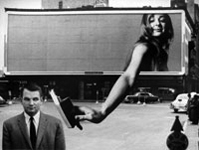Topics: Alfred Gescheidt, Higher Pictures
People used to say that the theater of the absurd is one part vaudeville and one part avant-garde. One could say much the same about Alfred Gescheidt, only one thing: be sure to update it for the visual arts and for America.
In fact, I already have. I spoke of vaudeville, where a French playwright like Eugène Ionesco would have known the theater of the boulevards, but I might just as well have recalled the classics of silent comedy. hangs from the side of a skyscraper by his fingernails, much as Harold Lloyd clung to the hands of a clock—and who is to say who is funnier or more in fear of his life.
Gescheidt, who died in 2012, knew fine-art photography as well as anyone. He took to the subways in 1951, for his first major series, much as Walker Evans had at least ten years before him. When he photographed skaters at Wollman Rink in Central Park, in 1965, they seem caught in the stillness of their own long shadows out of Paul Strand. His very vocabulary of black and white, photomontage, and a great deal of sex may make him the last and truestAmerican Surrealist, give or take Llyn Foulkes in California. He looks forward as well. When he shoots the curbs of Manhattan in wild and fragmentary perspective, for the series “Street Cleaner” in 1951, he belongs to that fascination with what Lee Friedlander was to call “America by Car.”
And this is most assuredly postwar America, of men on the subway isolated by light and shadow rather than joined in community of the Depression. It is increasingly a politically charged and polarized America, of George Wallace and Shirley Chisholm inserted into Grant Wood’s American Gothic in 1970, for Politics Makes Strange Bedfellows. It is also the America of advertising and commercial photography, the business with which he supported himself all his life. A snake coming out of a man’s fly, its skin all too close in texture to his jeans, could come right out of a Levi’s ad. More broadly, the photographs aim for that instantly memorable image, centered around a person and a product, only to take on afterward that extra punch of a title. And nowhere does Gescheidt sustain that formula longer or more ingeniously than in Thirty Ways to Stop Smoking in 1964.
His gallery introduced the photographer four years ago, with work starting in 1949, just when Ionesco was wrapping up his first comedy, La Cantatrice Chauve (“The Bald Soprano”). And no question but Gescheidt’s combination of high and low, as well as comedy and terror, was just then hitting its stride. Born in 1926, only two years before Andy Warhol, he lived and worked through Pop Art and the sexual revolution. Still, he hits his stride before Warhol, with deeper connections to the past, and for him popular culture is the medium more than the subject matter. Like advertising, he is photographing desire rather than photography. And now with that one series from 1964 in its entirety, recently at Higher Pictures (through August 2), the desires keep coming.
To borrow from myself four years ago, if I may, to save wasted words, still trying to quit smoking? You could morph the end of the cigarette into a combination lock—or light it with sparks from sticks of dynamite. You could die, impaled on a cigarette, or go up in a puff of smoke. You could lose yourself forever in a vending machine wanting more. You could put the cigarette on the couch to analyze its allure, your failure, or therapy itself. Then again, sometimes a cigar is just a cigar.
Maybe the old allure is starting to fade after all. Hey, it is already legit to worry about how to stop smoking, much as a movie star’s ever-present cigarette here gives way to the scrutiny of ashes under a magnifying glass. There is a time to laugh and a time to quit. And the allure of the male is fading most of all. He is so easily caught in a mousetrap, a herd of sheep, or a bottle. When a man with a mustache, a cane, a pocket handkerchief, and a bow tie poses beside a little girl nearly his size as his Lolita, he is anything but debonair, an intellect, or a victim.
In fact, he comes right out of the theater of the boulevards. Gescheidt needed rediscovery, in part because it took so long for the distinction between high and low culture to crumple, with surely a nod in acknowledgment to him. He also drew on early Modernism, at a time when art like science was supposed to be marching on. He also was more gentle than satirical, when the neo-Pop of the “Pictures generation” in the 1980s demanded otherwise. He leaves no doubt about his sympathies, political or otherwise. Yet he always leaves in doubt whether to feel most the comedy or the terror.
Note: I have added this to the earlier review, where Surrealism meets Madison Avenue, as my latest upload. (Talk about the mad in Mad Men.) That has meant, with apologies, my separating coverage of Gescheidt from a related article on the proverbial male gaze. It also tracks another half century of anxiety, but in England, as seen last time with Bill Brandt. Jack Gescheidt, the artist’s son, and Ray Madrigal, have interviewed me for a film in the works, and I have drawn on what I said—or at least what I wanted to say.
Read more, now in a feature-length article on this site.

